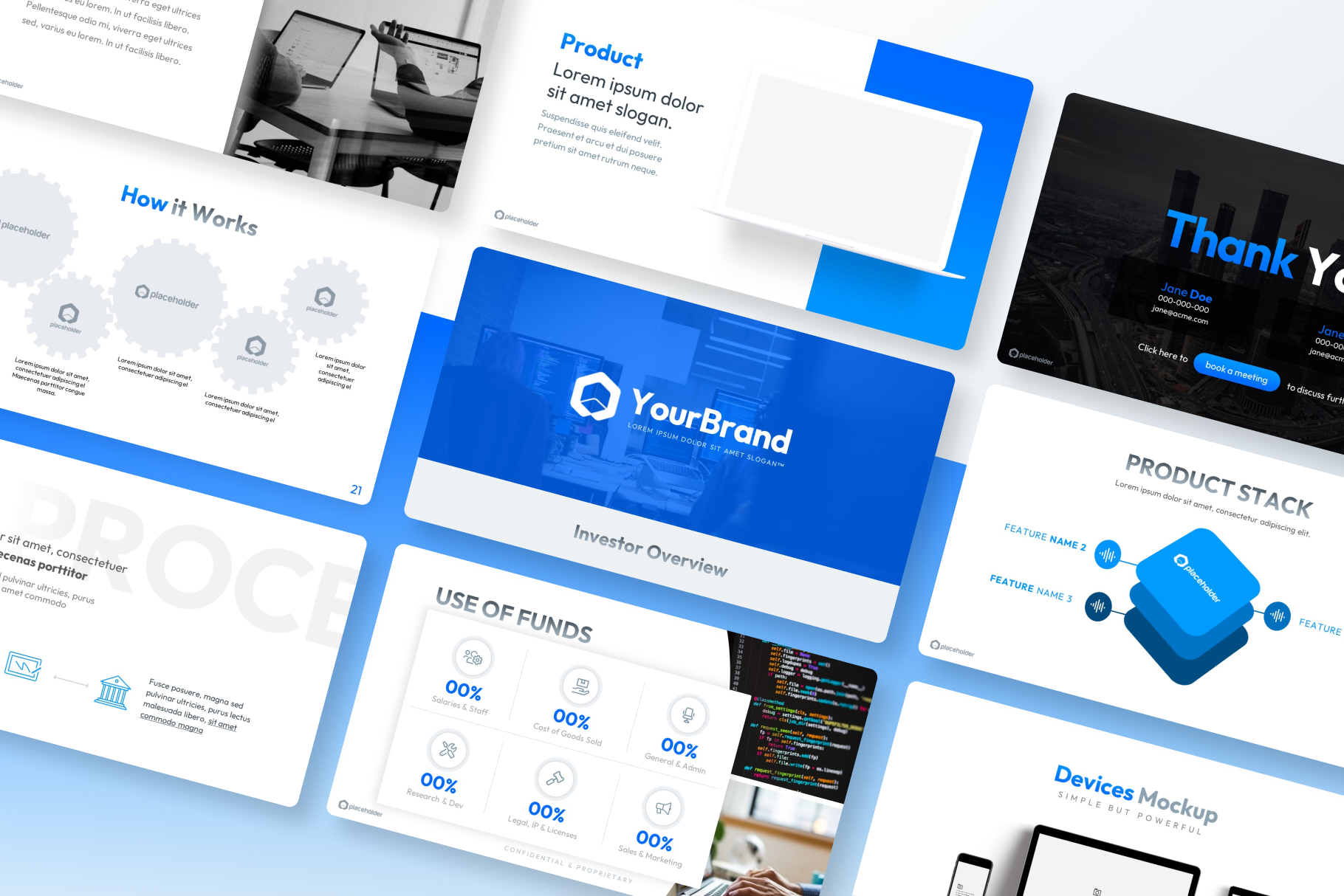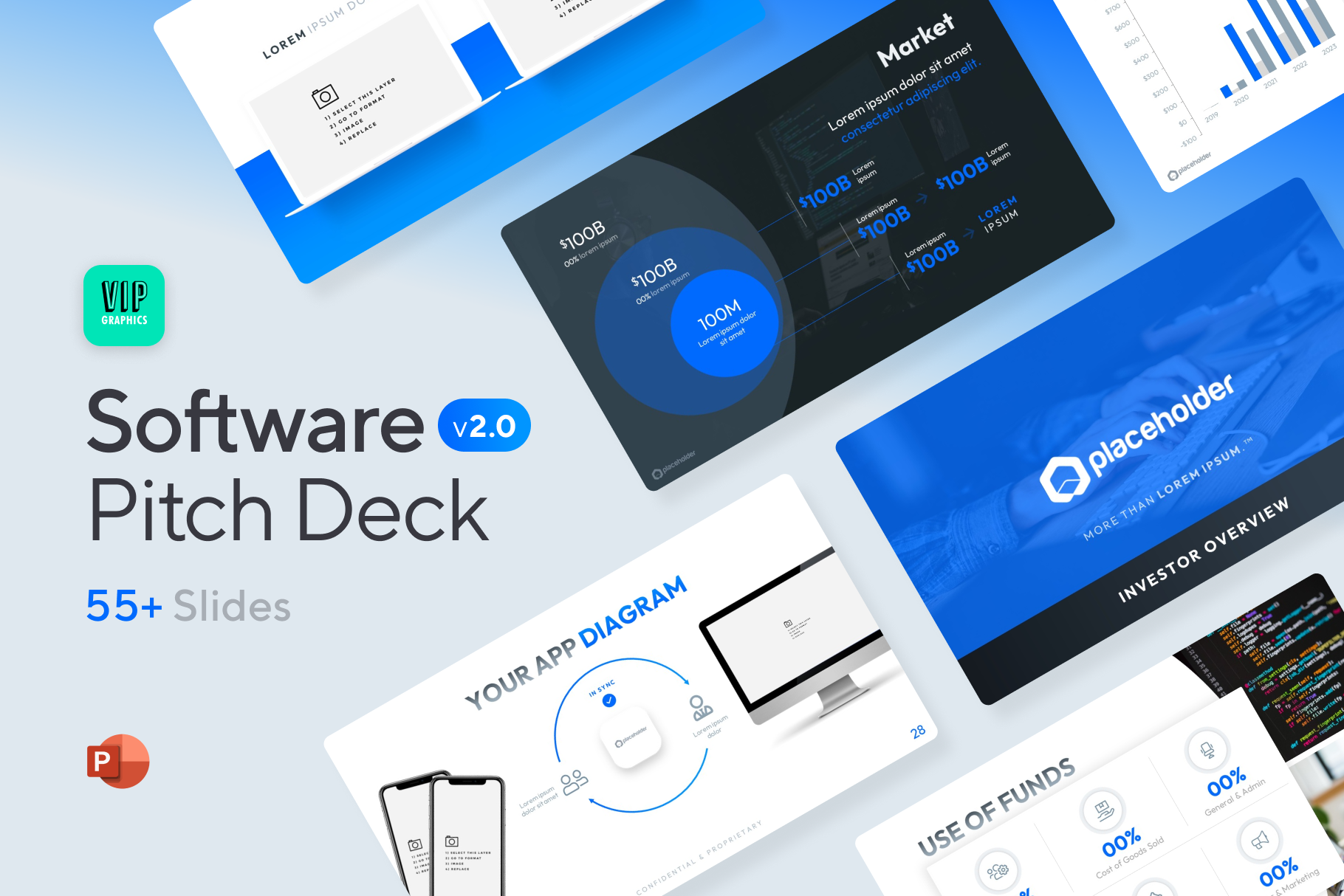The MarTech landscape is a dynamic ecosystem where innovation is the key to success. Large enterprises like HubSpot, Salesforce, and Adobe have redefined marketing with their robust platforms (think of HubSpot’s all-in-one marketing automation or Salesforce’s powerful CRM), while AI-enabled startups like Intercom, Copy AI and Supermetrics are disrupting industries with intelligent automation and hyper-personalized experiences.
In this hyper-competitive environment, crafting a compelling pitch deck is essential for securing investment and market share. This guide will guide you through creating a pitch deck that secures investment and propels your MarTech startup to the forefront of the digital marketing revolution.
What is a MarTech pitch deck? What is its purpose?
MarTech (short for marketing technology) is a competitive and booming industry where industry titans are often toppled by new startups. For MarTech founders, raising funding is critical to compete and scale their businesses.
Your pitch deck is a concise and compelling presentation that outlines a startup’s vision, product, market opportunity, and financial projections to potential investors.
Its primary purpose is to:
- Secure investment: Convince investors to fund the company’s growth and development.
- Communicate value proposition: Clearly articulate the problem the startup solves and the unique value it brings to the market.
- Generate excitement: Create enthusiasm and interest in the company’s potential.
What slides should be in your MarTech startup’s pitch deck?
Cover Slide
Your cover slide is prime real estate, so make it count. Present your company name, logo, and tagline in a clear and visually appealing way. Include your contact information so investors can easily reach out after they’re blown away by your presentation. Remember, first impressions matter – a polished and professional cover slide sets the tone for the entire deck.
Pro Tip: Invest in high-quality design elements and a consistent visual theme that carries throughout your slides.
Problem and Opportunity Slide
Hook your audience from the get-go by clearly defining the problem your MarTech solution addresses.
Highlight the pain points your target market experiences and quantify the problem whenever possible, using market data or statistics to illustrate the scope of the challenge. This sets the stage for your solution to emerge as the hero of the narrative.
Solution Slide
After explaining the “why” of your business, you can now introduce your product/service that solves it. Clearly explain how your solution addresses the identified problem and the unique value proposition it offers to customers.
Speak in simple, easy-to-understand language that resonates with your audience, even if they don’t have a deep technical background.
How It Works Slide
Your solution is brilliant, but how does it actually work? This is your chance to shine a spotlight on your product’s functionality. Ditch the complex technical diagrams and opt for clear, engaging visuals that walk investors through the user experience. Think screenshots, short explainer videos, or even UI mockups – whatever it takes to bring your product to life.
Pro Tip: Keep it simple. Remember, less is more. Avoid overwhelming your audience with information overload. Let the visuals do the talking, and be ready to dive deeper into the details during Q&A.
Competitive Advantage Slide
Clearly articulating your unique selling proposition (USP) is crucial. This slide should illuminate what sets your product apart from competitors. Don’t just say you’re better; show investors why you’re better. Position your product in the market and explain how you’ll carve out your own slice of the pie.
Pro Tip: Creating a competitive analysis grid can be a game-changer. Compare your product to key competitors across features, pricing, and target market. This visual representation gives investors a clear picture of your competitive edge.
Market Opportunity Slide
This slide is where you showcase the vast demand that your business will tap into. Delve into the size and potential of your target market, providing compelling data and statistics to support your claims.
Explain why this market is attractive and poised for growth. Include a market size chart or graph to visualize the potential and make complex data more digestible for investors. Investors are drawn to markets with significant upside, so make sure to paint a compelling picture of the opportunity.
Target Users Slide
Who are you building this for? This slide is all about your ideal customer profile (ICP). Don’t just throw out a generic description; dive deep into the nitty-gritty details of your target audience. What are their pain points? What keeps them up at night? How does your product solve their problems? The more specific you can be, the better.
Pro Tip: Creating detailed buyer personas can help bring your target customer to life. Give them a name, a job title, and even a backstory. The more human you can make them, the easier it will be to connect with investors.
Traction Slide
Talk is cheap, but results speak volumes. This slide is your opportunity to flex your milestones and achievements. Back up your claims with hard data, such as revenue, user growth, customer acquisition cost (CAC), or other relevant metrics. Highlight any partnerships, awards, or press mentions that validate your product’s success. And don’t forget those customer testimonials – they’re social proof gold.
Use visuals like a traction timeline or growth chart to make your achievements pop. A picture’s worth a thousand words, after all.
Business Model Slide
This slide should outline the core economics of your business. Show investors how the numbers add up and how your business will generate profit. Explain your revenue streams, pricing strategy, and cost structure in clear, easy-to-understand terms. This includes metrics like customer lifetime value (LTV) and customer acquisition cost (CAC). A strong LTV:CAC ratio is a compelling indicator of a sustainable business model.
Team Slide
Your team is the driving force behind your business, so this slide should highlight their expertise and passion. Introduce key team members and their roles, and emphasize their relevant experience and skills. Showcase the diversity of your team’s skill set and how it complements your product and market.
Pro Tip: Use high-quality headshots and keep the bios concise and impactful. Using logos instead of a long bio can be a great way to save space.
Investment Slide
You’ve laid out your vision and proven your potential, now it’s time to tackle the funds.
Clearly state the amount of funding you’re seeking and how you plan to use it to accelerate growth. Present your financial projections, including revenue, expenses, and profitability forecasts. Show investors how their capital will fuel your expansion and generate a healthy return.
Use visuals like a burn rate chart to illustrate your cash flow needs. This helps investors understand how their money will be used to fuel growth.
Roadmap Slide
Investors want to know where you’re headed. Outline your product roadmap, highlighting key milestones and future development plans. Demonstrate your ability to execute and scale your business. A well-defined roadmap inspires confidence and shows investors that you have a clear path forward.
Pro Tip: Keep your detailed roadmap focused on the next 12 – 18 months and avoid overly ambitious projections.
Vision Slide
Paint a compelling picture of your company’s long-term vision. Show investors how your product will disrupt the market and create significant value. Inspire them with your passion and ambition for the future.
Call-to-action Slide
You’ve made your pitch, now it’s time to close the deal. Summarize your key points and reiterate the investment opportunity. Encourage investors to take the next step, such as scheduling a follow-up meeting or discussing the investment further.
Examples of successful MarTech pitch decks
A well-crafted pitch deck is the cornerstone of any successful martech startup’s fundraising journey. But where do you even begin? Luckily, you don’t have to reinvent the wheel. Here, we’ll delve into some real-world examples of winning martech pitch decks that secured millions in funding:
- Mixpanel: This data analytics platform captivated investors with a clear and concise presentation. Their deck focuses on the “aha moment” – the pain point they solve and the value they deliver.
- Buffer: This social media management tool shines with its simplicity. Their pitch deck utilizes clear visuals and minimal text, making it easy for investors to grasp the core functionalities of the product.
- Intercom: This customer communication platform emphasizes customer centricity. Their deck showcases testimonials and success stories, highlighting the positive impact Intercom has on its users.
- Copy AI: This AI-powered copywriting tool utilizes a strong visual narrative. Their deck features compelling visuals and a clear value proposition, effectively communicating the power of their solution.
- Moz (formerly SEOMoz): This SEO software giant highlights the “why” behind their product. Their deck dives into the importance of SEO and the potential ROI for businesses, establishing the clear value proposition of their platform.
- Contently: This content marketing platform focuses on market opportunity. Their deck emphasizes the growing demand for content marketing solutions, showcasing the massive market potential Contently addresses.
Tips for designing a MarTech pitch deck (bulleted list):
- Don’t try explaining every feature: Focus on the value proposition for customers. Investors care more about how your product solves a problem and creates value than the intricacies of its functionality.
- Be succinct: VCs have short attention spans. Aim for a pitch deck that can be effectively communicated in less than 4 minutes.
Ready to captivate investors with your MarTech pitch deck?
Stop wasting time and resources on endlessly refining your pitch deck. Focus on what matters – delivering a winning pitch and growing your business. With this professionally designed Software Pitch Deck Template you can create a compelling narrative that showcases your MarTech startups unique value proposition and market potential. This expert-designed template is packed with industry-specific elements and stunning visuals, all easily customizable to fit your brand and story.

